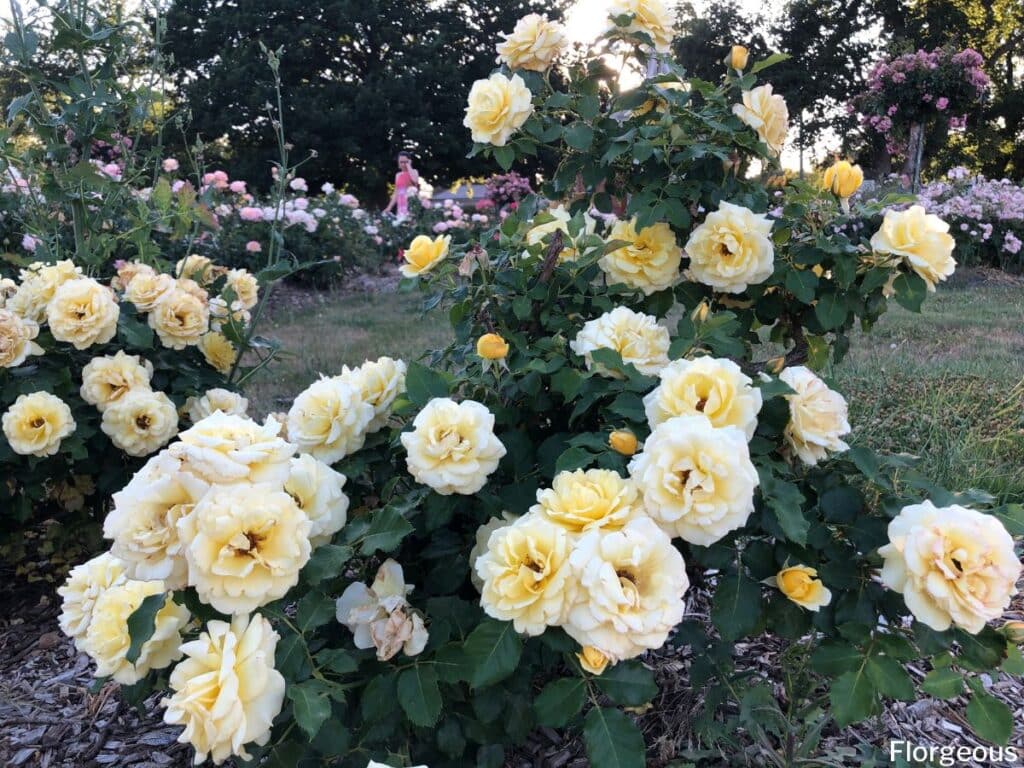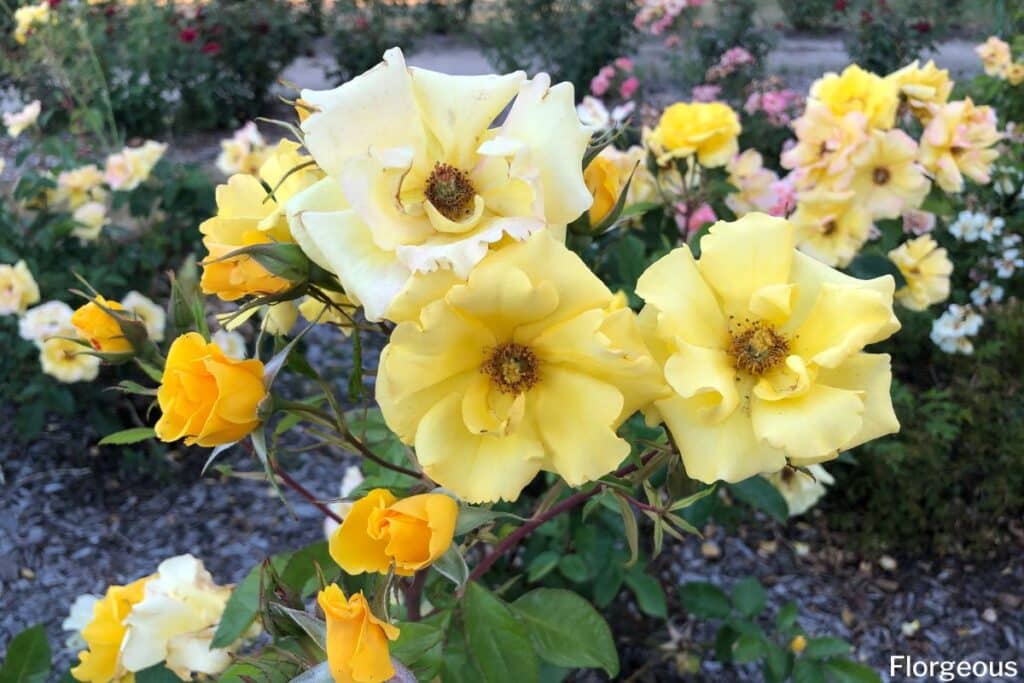Many have mistakenly believed that growing roses is complicated and demanding. Despite their delicate appearance, the truth is they can be easy to tend and can pretty much live in any kind of soil. That means there’s a high chance that you can grow them too in your garden!
However, roses thrive best under particular growing conditions. That includes having well-prepared and healthy soil. Proper rose soil preparation is needed to boost their performance both in the fields of aesthetics and defense against unwanted pests.
Hop in and fasten your seat belt as we journey through the basics of preparing the soil for different types of roses.
Preparing the soil for growing roses
Imagine having a rose garden. What can you see? What can you hear? What can you smell? But before you can actualize this beautiful picture of petals falling away in your mind, you have to start somewhere. That somewhere is in the soil.
Preparing the ground is an essential process to give roses a good start so they can be established well. Without a healthy soil foundation, they probably won’t last and fail your expectations — which is a real sad thing. Luckily, there are ways to ensure that you’re planting in good soil.
Understanding soil texture
First things first, know what cannot be changed — texture. It refers to how sandy, silty, loamy, or clayey your soil is depending on the abundant mineral particle. This is important because it influences drainage, water absorption, anchorage, nutrient holding capacity, and aeration.
Roses will prefer well-draining soil that can still hold an adequate amount of water. This is often a characteristic of loamy soil which is almost a balance of the properties of all particles.
Too much clay soil is heavy for them and there are tendencies to suffocate their roots. Silty soils are too slippery when wet and easily eroded by the wind when dry. On the other hand, sandy soils dry too quickly before the roots can absorb enough water.
There are various tests to determine what type of soil you have. One simple way is by using the jar test. To do this:
- Collect some soil samples from your garden and sift them using a mesh or a colander to remove stones and other debris.
- Fill a jar at most ⅓ full of the sieved soil. The remaining space will be filled with clean water. Add a teaspoon of liquid detergent.
- Shake the jar vigorously before settling it on a flat surface. Wait for about 2 days until the three particles separate from each other forming three distinct layers. The sandy soil stays at the bottom, silt in the middle, and clay on top.
- Measure the height of each layer and the total height of the mixture to get the percentages of the particles. Use the soil texture triangle to determine the soil type.
If the result shows that you are not starting out with the ideal texture, do not be disheartened because there are techniques to amend it.
The addition of organic matter in various forms including compost helps to loosen dense and compacted soils. The same ingredient also works for improving drainage and moisture retention of both sandy and clayey types.
Maintaining ideal soil pH
The pH measures the acidity and alkalinity of the soil. It is worth heeding because it influences how the roots can get the available nutrients.
If the pH level comes off the ideal range, the plants can be exposed to either lack or toxicity of certain nutrients even from nutrient-rich soil.
Roses thrive best in slightly acidic conditions with pH levels between 5.8 to 6.5. Too acidic soils can lock up nitrogen, phosphorus, and potassium; whereas, too alkaline ones can immobilize phosphorus, iron, and manganese. These are all essential nutrients and their deficiency is detrimental.
Most gardens fall in the ideal range of slightly acidic to neutral. But these measurements change from time to time and place to place. It is recommended to test the pH level on a regular basis.
You can have it done from a university extension service or other private laboratories. There are also test kits and devices available in the market for rapid testing.
There are many methods to tweak the pH and make the conditions better for growing roses. To raise the pH level, calcium-containing minerals such as lime, gypsum, and dolomite can be added. In contrast, sulfur-containing minerals such as ferrous sulfate and aluminum sulfate increase acidity.
Although it is possible to correct the pH, it does not happen overnight. Experts can guide you on how much of this or that to apply. However, it is still a hit-or-miss work that requires repetitive testing.

Enriching the soil
In order for roses to produce beautiful blooms, they need to be healthy first. They are known to be heavy feeders and providing the right amount and nutrients will make the best out of them. Otherwise, they can become really grumpy without proper nutrition.
Most gardens are naturally-rich. However, they become depleted over time as plants use up these nutrients. Fortunately, it is easy to enrich the existing soil by adding either organic or synthetic fertilizer products.
Applying fertilizers must be done during the onset of spring when newly-formed leaves appear.
The fertilizer will support the plant throughout its growing season. Most species will also benefit from a second feeding after the first bloom cycle. But do not add fertilizers six to eight weeks prior to the frost date because it will encourage new growth that will only be damaged by the season.
Both organic and synthetic fertilizers provide nitrogen, phosphorus, and potassium at a certain level. They come in various forms such as liquid solution, foliar spray, powder, or granular.
Roses love being fed with complete fertilizers, containing all N-P-K, with a higher phosphorus ratio. The element phosphorus helps promote stronger root systems and abundant flower production.
Organic fertilizers vs synthetic fertilizers
Organic fertilizers are derived from plant-based or animal-based materials. When added to the soil, they slowly release nutrients as they undergo decomposition which makes them the best food for roses.
When used properly, they don’t damage the soil or burn the plants. Instead, they stimulate the activity of beneficial microbes while also improving water retention in the soil.
They contain a lower concentration of N-P-K than synthetic fertilizers and their effects are more subtle. Examples are compost, vermicast, blood meal, alfalfa meal, decomposed animal manure, and seaweed extracts.
On the contrary, synthetic fertilizers are generally derived from by-products of the petroleum industry including ammonium and sulfates. They are mostly dissolved in water which is quickly absorbed by the plants.
In return, the effects are noticed immediately. However, their solubility in water is also their downside. Nutrients are easily leached into waterways that can be damaging to the environment. Applying too much can also burn plants and destroy life in the soil.
Conserving the soil for roses
One effective way to conserve and protect your garden soil is by adding organic mulch. Mulching not only helps the soil retain moisture but also serves to suppress weed growth, providing a dual benefit for your plants. Additionally, it plays a crucial role in regulating soil temperature, supporting the root system as they absorb essential nutrients.
Good choices of organic mulch for roses include organic compost, leaf moldings, hay, shredded bark and some peat moss.
To do this, water and feed your roses first before applying any mulch. The area should also be clear from old weeds. Spread 2-3 inches thick of the chosen mulch around and all over the root zone. You can also add animal manures underneath the mulch layer.
Rose Potting Soil
Some gardeners want their plants to grow in pots on their patio. To be fair, container-grown plants offer advantages which include maximizing space, motility of the plants, and more control of moisture levels over field-grown ones.
Roses can flourish in planters and pots as long as the potting soil can provide the same growing conditions they will need when planted in garden soil. Roses prefer soil that can hold enough water, drains well, and is nutrient-rich.
There are lots of soil mixes suited for planting roses that can be purchased from many garden stores. They can either be peat-based, coir-based, or compost-based. Some may also contain fertilizers to boost your roses with minerals and vitamins.
More About Roses
The rose bushes have become a part of various special occasions including wedding ceremonies, anniversaries, Valentine’s, birthdays, and even funerals anywhere in the world.
When given to someone as a gift, it communicates unspoken feelings of love, desire, peace, and admiration. Thanks to its pleasant fragrance and mesmerizing form that touches anyone’s heart.
See more: What do different color roses symbolize?
Botanical Description
The plant we all know today as the rose is a group of more than a hundred species belonging to the genus Rosa of the Rosaceae family. They are native to the temperate regions of the Northern Hemisphere primarily in Asia. They can either be erect, trailing or climbers.
The woody stems which have copious thorns to protect from herbivores are quite noticeable in all species. The leaves are sharply toothed and are arranged in an alternate and pinnately compound pattern. The flowers vary in shapes, sizes, and colors while the berry-like fruit is called a hip.
Brief History
The rose can be considered one of the most ancient flowers in world history. It is believed to have existed for at least 35 million years based on the earliest fossil evidence found in Colorado.
Records show that China was the first to cultivate the plant 5,000 years ago while the Middle East started to grow it on a mass scale during the Roman period.
The long period of cultivation is by means proof of its fame and functionality in the culture and tradition of the olden days.
Its remarkable presence in literature including the Greek Mythology, poetic works of William Shakespeare, and paintings on walls and artifacts of Egyptian tombs depict an intimate and special bond with humans. No wonder it is the favorite of many; hence, the nickname “Queen of Flowers”.
FAQs
Which compost is best for roses?
The best compost for roses is a rich, well-rotted organic compost that provides essential nutrients and improves soil structure. Compost made from kitchen scraps, leaves, and garden trimmings works well and should be aged before use.
Are coffee grounds good for roses?
Yes, coffee grounds can be good for roses in moderation as they add organic matter and can help increase soil acidity slightly. Use them sparingly and mix them into the soil to avoid clumping and to prevent potential mold growth.
Do roses like acidic or basic soil?
Roses prefer slightly acidic to neutral soil, with a pH range of 6.0 to 7.0. Maintaining the right soil pH helps the plants absorb nutrients more efficiently.
Are eggshells good for rose bushes?
Yes, eggshells can benefit rose bushes by providing a slow-release source of calcium, which can strengthen the plant’s cell walls and help prevent issues like blossom end rot. Crush the eggshells finely and work them into the soil around the roses.
Are banana peels good for roses?
Yes, banana peels are good for roses because they contain potassium, which supports strong root growth and overall plant health. Chop the peels and bury them around the base of the plant, or use them in compost to feed your roses naturally.
Learn more:







